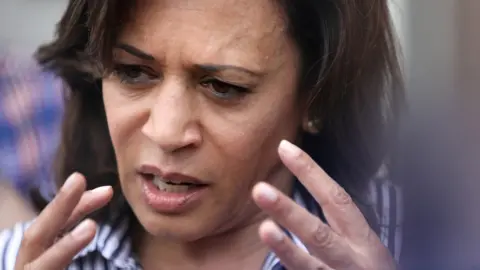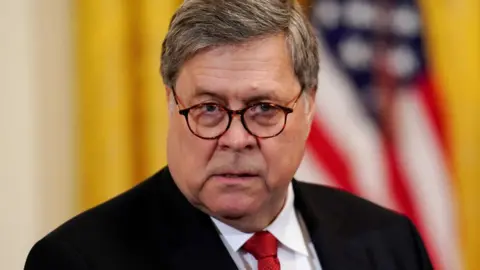US government death penalty move draws sharp criticism
 Reuters
ReutersThe US federal government's move to resume executions after a 16-year hiatus has drawn sharp criticism from rights groups and leading Democrats.
Several candidates for the Democratic presidential nomination called for the death penalty to be abolished.
On Thursday Attorney General William Barr said five inmates would be executed.
They had been convicted of murders or rapes of children or the elderly, he said.
The executions have been scheduled for December 2019 and January 2020.
"Under administrations of both parties, the Department of Justice has sought the death penalty against the worst criminals," Mr Barr said in a statement. "The Justice Department upholds the rule of law - and we owe it to the victims and their families to carry forward the sentence imposed by our justice system."
Mr Barr's announcement lifts what was an informal moratorium on the federal death penalty - as opposed to state-directed executions - since the 2003 execution of Louis Jones Jr, a 53-year-old a Gulf War veteran who murdered 19-year-old soldier Tracie Joy McBride.
What has the reaction been?
Robert Dunham from the Death Penalty Information Center said the decision did not come as a surprise.
"President Trump has been a staunch supporter of capital punishment and has proposed several extreme uses of it, including for selling drugs and for all murders involving state and local police officers," he said.
"So it was not a surprise that he would seek to have executions carried out. I think the biggest surprise is that it took as long as it did."
Meanwhile the American Civil Liberties Union (ACLU) said the fact that the executions had been scheduled close together raised "serious questions about the fairness for each of those cases".
"We need time to consider and review cases and there's just absolutely no basis for lumping cases together in this way and rushing forward," said Cassy Stubbs from the group.
Democratic presidential candidate Kamala Harris described the death penalty as "immoral and deeply flawed", while Bernie Sanders said he would abolish it if elected.
Another candidate for the Democratic nomination, Pete Buttigieg, said "race and geography" were factors in determining who was sentenced to death.
Who is the US government planning to execute?
They are Daniel Lewis Lee, a white supremacist who was convicted in Arkansas of murdering a family of three; Lezmond Mitchell, a Native American who was convicted in Arizona of murdering a grandmother and her granddaughter; Wesley Ira Purkey, who raped and murdered a teenage girl; Alfred Bourgeois, who sexually molested and killed his young daughter; and Dustin Lee Honken, who shot five people dead.
 Getty Images
Getty ImagesMr Barr is to allow the prison authorities to use the single drug Pentobarbital in place of a three-drug procedure previously used in federal executions. The drug is a potent sedative that slows down the body, including the nervous system, to the point of death.
The five executions to be scheduled would take place at the US Penitentiary at Terre Haute, Indiana, and additional executions would take place at a later date, the justice department said.
When do federal courts hand down death sentences?
Under the US justice system, crimes can be tried either in federal courts or state courts, at a regional level. Certain crimes that apply nationally, such as counterfeiting currency or mail theft, are automatically tried at a federal level. If an offence is committed against a federal entity or at a federal building or other property, then it will be tried at federal level.
 Reuters
ReutersThe death penalty was outlawed at state and federal level by a 1972 Supreme Court decision that cancelled all existing death penalty statutes. Four years later, a Supreme Court decision reinstated the death penalty to a number of states and in 1988 the government passed legislation that made the death penalty available again at a federal level.
According to data collected by the Death Penalty Information Center, 78 people were sentenced to death in federal cases between 1988 and 2018 but only three have since been executed, the last one in 2003.
There are 62 inmates currently on federal death row.
They include Dylann Roof who murdered nine people in a Charleston church in 2015, and Dzhokhar Tsarnaev, who was convicted of the 2013 Boston Marathon bombing.


For more than a decade and a half, the federal death penalty was mostly an afterthought. Although there was no formal moratorium on the procedure, as there was in some states where opposition to executions has been growing, a combination of administrative inertia, protracted appeals processes, practical obstacles and the relatively few number of federal death-row inmates combined to grind executions to a de-facto halt.
The Trump administration now wants to change that, even if a shortage of the drugs used in lethal injections remains a significant obstacle.
The president has expressed a harsh attitude toward convicted criminals in the past, claiming that they are treated too gently and given too many opportunities to appeal against their sentences.
While a majority of Americans say they still favour the death penalty in certain instances, opinion surveys indicate that the American public is turning against capital punishment, with a particular eye toward allegations that it is frequently unjustly imposed.
That suggests that while the Trump administration's announcement will draw some sharp criticism from activists, it is unlikely to cause significant political waves.
Capital punishment in the US
- The death penalty is a legal punishment in 29 US states
- Since 1976, Texas has carried out the most executions (561), followed by Virginia (113) and Oklahoma (112)
- There are 2,673 inmates on death row in the US
- California has the most prisoners on death row - 733 - but has carried out only 13 executions since 1976
- The annual number of death sentences fell by 85% between 1998 and 2018 - from 295 to 43
Source: Death Penalty Information Center
